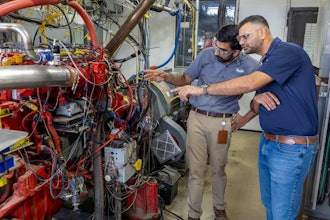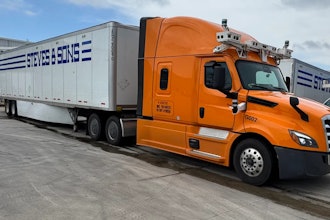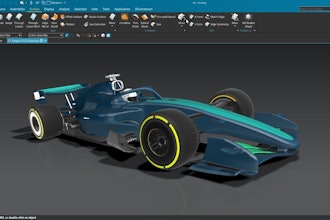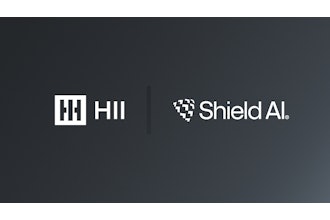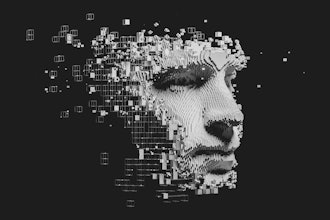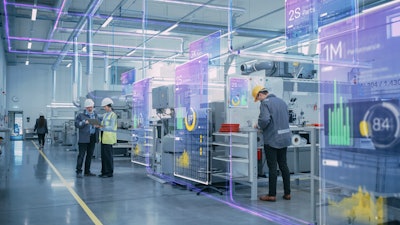
With some of America’s legacy operators being in business for over a hundred years, they have acquired a long backlog of designs - often going back to the 1920s or earlier. Of course, schematics for these designs are not kept on their original centuries-old paper. Today, many legacy manufacturers are uploading their oldest documents into online databases for safekeeping.
The image of a one-hundred-plus-year-old design being uploaded to the cloud is emblematic of how manufacturing has — and must continue - to evolve in the face of technological advancement. Whenever any business needs to advance technologically, a core challenge is the successful implementation and adoption of new tools.
The manufacturing industry also faces unique challenges due to the age structure of its workforce. In 2023, 51 percent of all manufacturing workers were over the age of 45 and this figure will only grow. With an increased demand for skilled workers and a vacuum of necessary skills amongst younger workers, getting the most out of industry veterans will become increasingly critical for manufacturers.
For that reason, when industry leaders implement AI and IoT technologies, they need to make sure the strategies they develop and tools they purchase conform to three rules for intergenerational success.
1. Design a Tool with Functionality in Mind
New technologies need to be easy to use. In any company, implementing new systems poses adoption challenges. The first hurdle is whether or not employees even bother to use the technology. This struggle is especially acute in intergenerational firms.
While young professionals may be easily convinced to invest the time and effort needed to understand a complex system, experienced employees can be disinterested. Having learned how to do tasks ‘the old-fashioned way,’ adding additional layers of complexity can be a tough sell. The most critical factor in determining an AI or IoT product’s ease of use is the quality and simplicity of its user interface (UI). A good general rule is that a tool should be as easy to understand and start using as Google Drive.
2. Ensure Widespread Usage Across Departments
The second rule is related to the previous one, but touches on a separate issue facing manufacturers: the need for tools to be used across departments. Although departments like engineering, procurement, and fabrication operate under the same roof, too often they are divided by different technology systems.
Take engineering, for instance. Engineers and designers are taught to think about particular problems in a specific way. They are also taught how to use specific software to design solutions. Autodesk, the software company that develops AutoCAD, is not successful because its products appeal to the largest market possible. Their success is a result of building software specifically for engineers.
Although Autodesk has captured one group of manufacturing workers, its popularity hinders communication between departments. This is because Autodesk does not design for non-engineers, making cross-departmental work difficult. Working with many different software platforms also decreases intergenerational productivity because it increases the number of tools a hesitant worker has to learn. Finding a solution that serves all departments is a more effective fix.
3. Leverage Specialized AI for Niche Industries
Finally, manufacturers need to avoid giving in to the AI hype. That’s not to say AI isn’t important or that it doesn’t present enormous opportunities for the manufacturing industry. It does, but not in the same ways it does for other industries. For that reason, industry leaders need to learn to look past what’s popular and identify practical solutions specifically tailored to manufacturing problems.
Companies like OpenAI or Google might seem like they’re on the edge of AI development. The reality is that they are only at the forefront of general-purpose, consumer-facing algorithms. AI experts make a distinction between horizontal and vertical AI. Horizontal AI describes programs that have a wide range of applications but with no specialization. Vertical AI refers to systems that are designed to tackle a specific problem.
When you have an exact, industry-specific problem you want to solve, using a vertical AI trained on data related to that problem yields far better results. Specialization also helps experienced workers master the system faster. Being designed for purpose means that these systems need less prompting to get the correct result, making it easier for workers to master.
ChatGPT would be an example of horizontal AI, while a program designed specifically for one or more problems faced by the manufacturing industry would be a vertical AI. When implementing AI, manufacturers should look beyond popular horizontal AI systems and find tools that help them deal with the problems they’re facing.
By following these three principles, you can find the most effective technologies to help your intergenerational workforce stay ahead of emerging trends. Doing so will set your company up to survive and thrive over the next one hundred years.
Yushiro Kato is the founder of CADDi, a manufacturing platform that automates the connection between buyers and suppliers. Learn more at Drawer.CADDi.com










